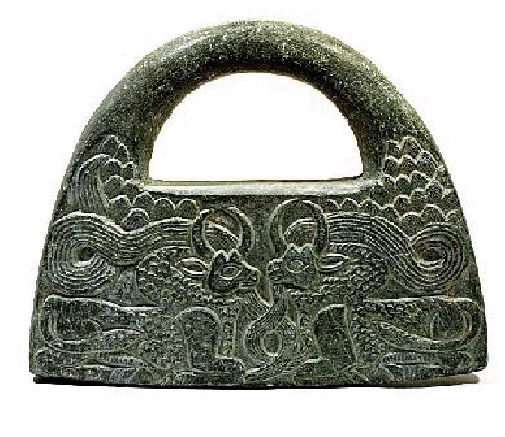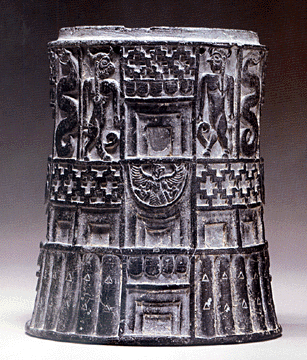In recent years the discovery of an ancient previously unknown culture at Jiroft in South West Iran has made possible the development of clearer insight into the tradition of 'stargates' in Near Eastern early bronze age culture.
www.heritageinstitute.com...
www.cais-soas.com...
Jiroft, probably to be identified with the City of Aratta known from Sumerian texts, was like Sumeria itself almost certainly a Dravidian culture, maintaining trade links with the Harappan culture of the Indus valley, in a sense the missing link between Sumerian and Harappan culture.
The Sumerian legend, Enmerkar and the lord of Aratta, establishes that Aratta had highly skilled and much sought after craftsmen, which the Sumerians sought to employ for their own usage in constructing a ziggurat after the fashion of that at Aratta, which was dedicated to Inana and were her cult was pre-eminent, thus the Goddess and her tradition seemingly were derivative of Aratta.
etcsl.orinst.ox.ac.uk...
This is important in that Inana/Ishtar held primacy in the cosmological stargate tradition;
http://www.abovetopsecret.com/forum/thread871055/pg1
....the queen of heaven and earth, the goddess of the numerous me, holy Inana, has brought to Aratta, the mountain of the shining me
Inana, the lady of all the lands, has surrounded Aratta, on its right and left, for her like a rising flood. They are people whom she has separated from other people, they are people whom Dumuzid has made step forth from other people, who firmly establish the holy words of Inana
Inana was ruler of the mountain were the sun rose and set, thus ruler of birth and death, the mountain in an astrological sense being the zodiacal light, in a natural sense mountains of the distant horizon, in a symbolic sense the great ziggurat of Aratta...more on this here;
www.abovetopsecret.com...

Thats the basic cultural context then, in considering the iconography of Jiroft and Proto-Elamite culture as concerned with stargates, this rudimentary jug is a good starting point;

At first glance, and second, that could easily be seen as an Egyptian representation of the Akhet symbol, the sun between the two mountains of the horizons, and with good reason, for it is a Proto-Elamite version of the same.
One takes the same key iconography then and considers it in a slightly more complex context;

There again one finds the 'two mountains' representation, albeit without solar disc, set beneath an arc/handle which will be seen to be correspondant to the arc that the sun traverses across the sky, with interwoven serpents either side, which will be seen to correspond to means of passage.
To confirm this is correct interpretation, one considers an example were the two mountains of the horizon are represented in more naturalistic form beneath the arc/handle, in conjunction with the 'Bull of Heaven' dominating both horizons, this astrological symetery being common as seen in subsequent examples.


as well as the importance of the serpents in facilitating transition across the axis of the horizon;

In achieving mastery over these twin serpents a hero figure or Deity established himself as a Lord of the two horizons, Lord of Life and Death, birth and resurrection.


Inana having supreme rule over such concepts could actually assume the form of the twin serpents herself;

A furthur critical aspect is the symbolic form that the mountain of the horizon could take;



As in Andean culture and others, in 2D representational form this is a stepped construct, with the two mountains of the horizon also lending themself to the singular motif of the diamond stepped form were they are seen as symetrical opposites, with the cross denoting centre as a derivative, as in the chakana.
This basic stepped form, as seen in this Elamite bronze concerned with rites of sunrise, represents the mountain of the horizon, in the same manner an Andean Huanaca does of similar form.

These then are the elements which one should be looking for in connection with the representation of the cosmological stargates/portals, and thus;






It can be seen that the portals are placed in the context of a general architectural setting, and thus archaeologists somewhat lazily conclude this is merely representation of the general city, however it must be noted the Egyptians contextualized their Doorways of the Horizon of Heaven in terms of a Palace Facade, and that this can be seen as representative of the Heavens, thus the mundane reflects the Heavenly;
www.abovetopsecret.com...
A furthur intriguing consideration is that the symbolism involved lends itself to application in terms of traversing time and space via worm hole travel, it is as if the symbolism of the religious premise was created to accomodate this extension of meaning.
The natural premise for the mystical mountain of transition at the horizon was the zodiacal light, which is simply diffuse particles reflecting along the ecliptic plane when the sun is beneath the horizon, this ephemeral vision taking symbolic form in the mighty physical construct of the ziggurats and pyramids, the vision made manifest
These portals then in the cosmological sense are concerned with transition across the horizon, via serpents, creating cyclic transition between life and death;

edit on 13-8-2012 by Kantzveldt because: (no reason given)
